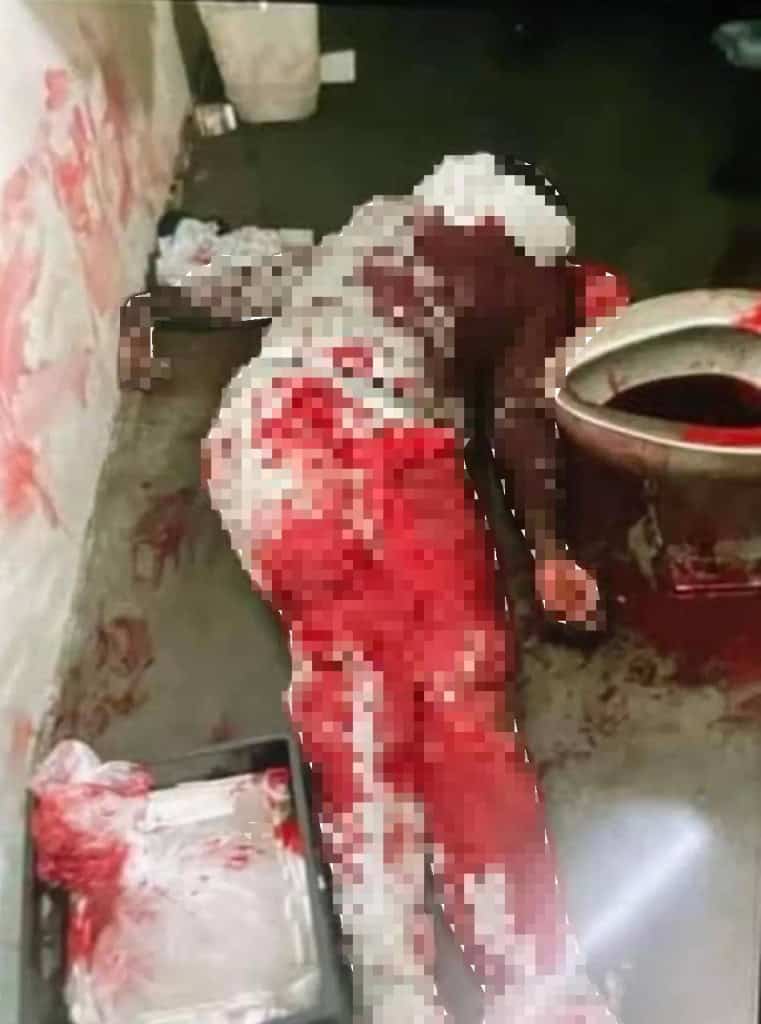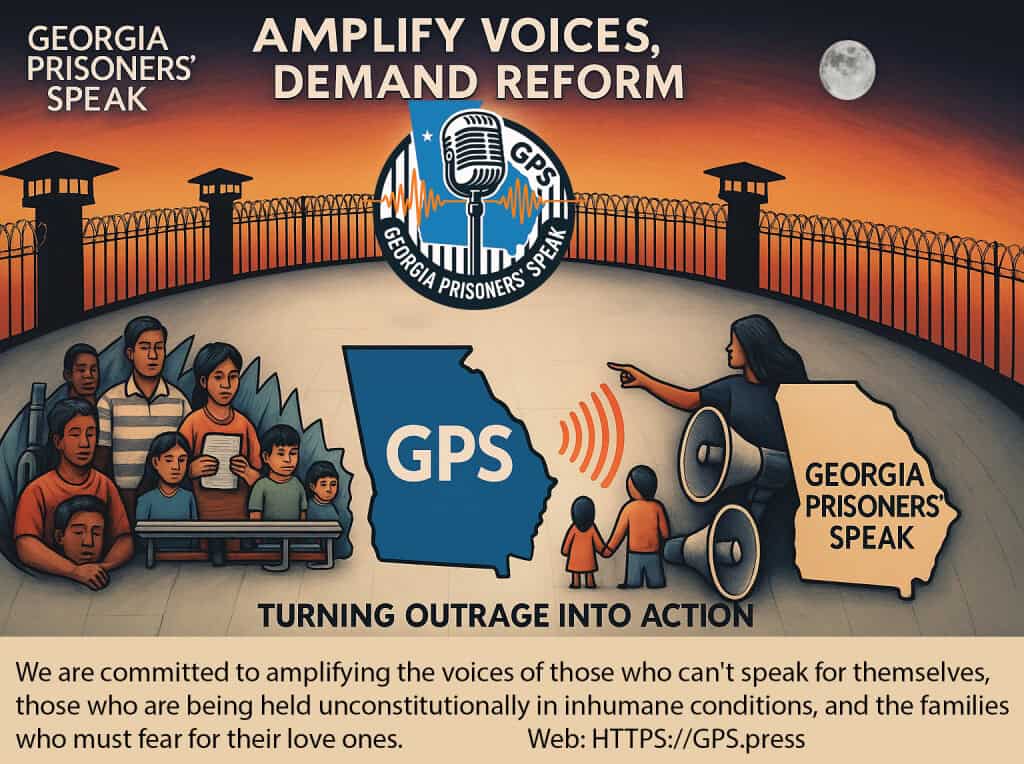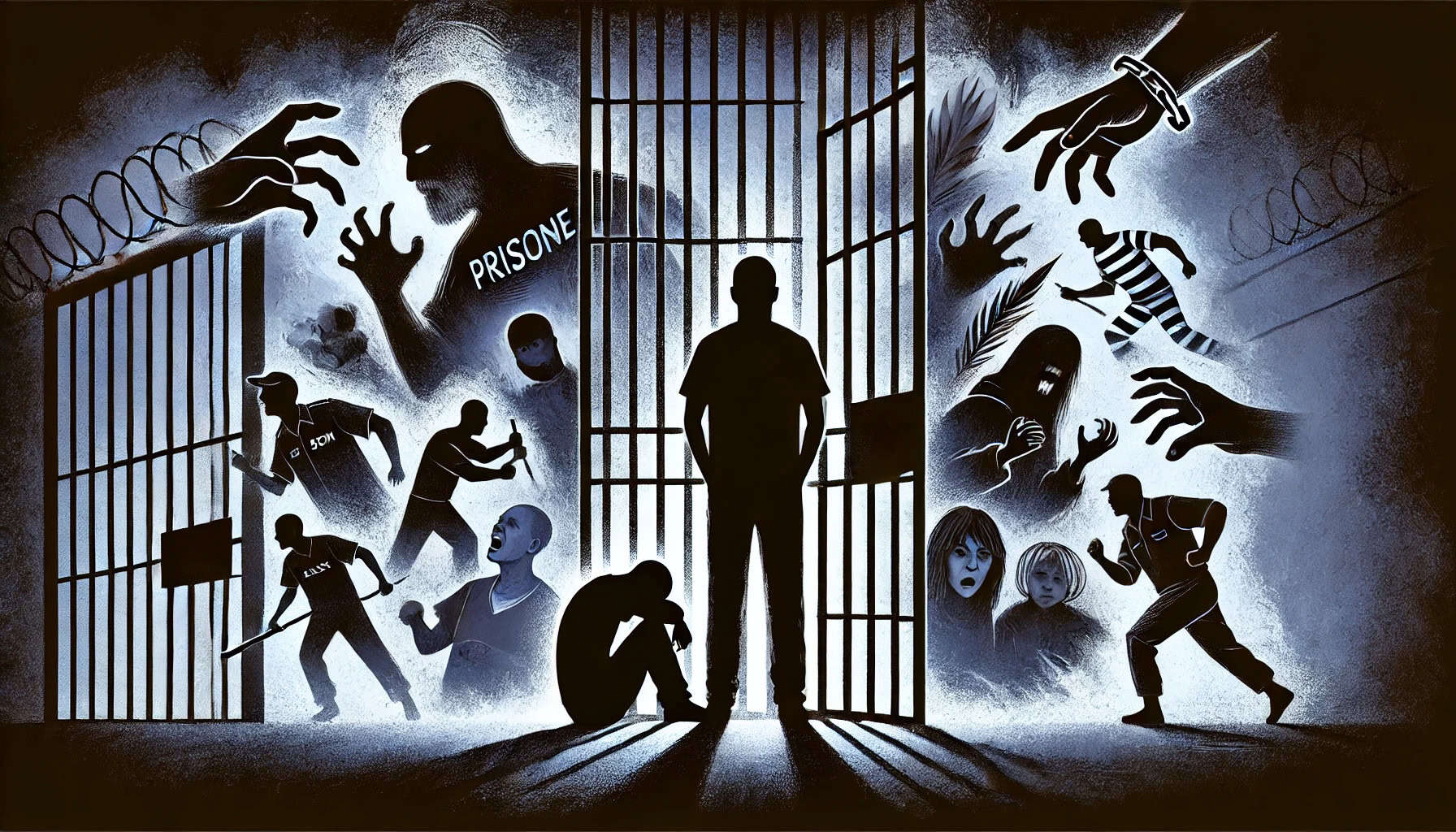This is part one of a series of articles on the trauma and abuse Georgia prisoners experience. Names have been changed to protect prisoners from retaliation. You can read part two here: Invisible Scars: Cycle of Retaliation and Abuse in Georgia Prisons
The Unseen Victims: Witnessing Violence in Georgia Prisons
Georgia’s prisons are notoriously violent environments, a harsh reality that extends far beyond the immediate victims of physical attacks. Countless inmates suffer silently as witnesses to horrific violence, enduring significant psychological trauma that often goes unnoticed and untreated.
Witnessing Horrors: Real Stories from Inside

Life inside Georgia’s prisons is marred by relentless violence that leaves deep psychological scars on those who witness it. Many prisoners carry traumatic memories of brutal assaults, stabbings, and even deaths they were powerless to prevent.
One prisoner vividly described a chilling experience:
“I watched in horror as I saw a man I knew to be a good guy, a friend, get stabbed through the chest. He stumbled down the stairs trying to yell for help, the only thing coming out of his mouth was blood and gurgling. Once downstairs, he walked about 15 feet before falling to the ground, desperately gasping for breath as his lungs filled with his own blood. A pool of blood grew on the floor around him as other prisoners tried to help him. There were no officers to be found. For 30 agonizing minutes, we watched helplessly as this man grasped for air until it was obvious he had died. Officers finally arrived, but their only response was to lock down the dorm. We all sat in our cells for weeks during lockdown horrified by what we witnessed, with no one to talk to about our trauma except our roommates. Sleep came in fits as the scene replayed endlessly in our nightmares. The staff didn’t care about the man who was killed or the trauma we were experiencing. They only cared about their reputation and hiding the evidence. I will forever carry these images in my mind.”
At Jackson State Prison, an inmate described similar horror and helplessness:
“I’ve been inside maybe six times, and I’ve seen people die right beside me. If you go to prison for two years, it shouldn’t be a death sentence. At Jackson, I saw a guy who was there on a probation violation with just a few months left—he was killed right beside me. There was nothing I could do except keep my mouth shut because I didn’t want to get killed myself. The guards don’t care. We’re all just numbers to them.”
Another disturbing incident occurred at Charles D. Hudson Transitional Center, where officers themselves incited violence:
“CERT Team from Rutledge, under the direction of Lt. Lonesca Carlton, entered our building around 4 a.m. and assaulted multiple residents. Without justification, Resident Michael Schullerman was beaten until his lip split open, requiring 12 stitches. He was forced under threats and coercion to write a statement falsely claiming he fell from his bottom bunk. Officers threatened him with more beatings if he didn’t comply. His statement was written out of intimidation and fear. This kind of brutality and psychological warfare is routine, leaving us living in constant fear of what might come next.”
A horrific account from the Georgia Diagnostic and Classification Prison reveals the routine violence inmates face upon arrival:
“Alexander Stetz recounts being attacked shortly after his arrival: ‘I had two or three gang members with knives standing in front of me, demanding money. When I insisted I had nothing, someone stabbed me right in the neck from behind. I suffered permanent nerve damage to my hand. There were weekends with literally three guards for hundreds of inmates, which made violent encounters inevitable.’”
The traumatic impact on prisoners who witness such brutal acts cannot be overstated. Prisoners frequently report suffering nightmares, severe anxiety, PTSD symptoms, and deep depression, exacerbated by a lack of counseling or psychological support. In many cases, these traumatic experiences are compounded by systemic neglect and corruption.
A recent DOJ report underscores these realities, highlighting the chronic violence and lack of intervention or adequate medical care in Georgia’s prisons 1. The fear prisoners live with is a form of psychological torture, creating an environment where trauma and violence feed into an endless cycle.
Another former inmate from Georgia’s Jackson State Prison shared a stark reflection on the broader psychological damage inflicted:
“This isn’t just about surviving physical violence. It’s about witnessing cruelty, helplessness, and death, knowing you can do nothing to stop it. These images don’t leave your mind. They haunt you long after you’re released. Many prisoners become shadows of themselves, stripped not just of freedom but of their humanity.”
The psychological toll of witnessing violence is immense and enduring. This trauma often goes untreated, leaving prisoners to cope alone. Such conditions exacerbate mental health issues and make reintegration into society after release even more challenging, further perpetuating cycles of incarceration and recidivism.
Georgia’s prisons urgently need systemic change—not just in policy, but in recognizing prisoners as human beings deserving of dignity, safety, and rehabilitation. Until this change happens, inmates will continue suffering unseen and unheard, burdened by the horrors they’ve witnessed.
The Psychological Impact of Witnessing Violence
Research confirms that witnessing violence can have profound psychological consequences, similar to direct victimization. A Prison Policy Initiative report highlights how witnessing prison violence can lead to post-traumatic stress disorder (PTSD), depression, anxiety, and other severe mental health conditions 2.
Moreover, studies published in Clinical Psychology Review indicate that inmates exposed to violence face significantly higher risks of PTSD and other disorders, severely impacting their mental well-being and prospects for rehabilitation 3.
The trauma of witnessing violence can have devastating, lifelong consequences, profoundly impacting an individual’s mental and emotional health. When this trauma occurs within the confines of a prison—a space defined by confinement, control, and vulnerability—the effects are even more severe and long-lasting.
Prisoners who repeatedly witness violence—assaults, stabbings, severe beatings, or deaths—frequently develop symptoms associated with post-traumatic stress disorder (PTSD). Common manifestations of trauma include nightmares, flashbacks, anxiety, depression, and hyper-vigilance. Witnessing violence, especially extreme acts like stabbings or killings, can fundamentally alter an individual’s perception of safety and trust, creating a perpetual sense of fear and helplessness.
According to psychological research, witnessing violent trauma—even if not directly experiencing physical harm—can trigger severe PTSD and depression symptoms. Studies specifically focused on incarcerated populations highlight that prolonged exposure to violence significantly increases the risk of psychiatric disorders and behavioral problems. In a landmark study on trauma exposure in incarcerated individuals, researchers found that prisoners who had witnessed frequent episodes of severe violence exhibited rates of PTSD comparable to war veterans and torture survivors 4.
The Unique Psychological Torment of Prison Witnesses
The prison environment creates a uniquely damaging psychological context. Unlike those who witness violence in the free world, prisoners have limited access to mental health services, support networks, or effective coping mechanisms. The GDC environment exacerbates trauma by isolating individuals and limiting their ability to seek help or even process traumatic events effectively.
The prisoner who described watching a friend die above, vividly described the trauma from witnessing the murder:
“I watched in horror … I sleep in fits; I keep seeing it in my dreams. No one cared about the trauma we were going through.”
The prisoner’s account vividly captures the helplessness, emotional isolation, and persistent trauma of witnessing violence within Georgia’s prisons.
Fear as a Constant Companion
Beyond PTSD, witnessing prison violence fosters a chronic state of fear and anxiety. Prisoners often describe being in a constant state of heightened alertness, or hyper-vigilance, as they try to anticipate and avoid potential threats. According to research from the National Institute of Corrections, this perpetual state of stress can lead to chronic anxiety, high blood pressure, and increased risk for cardiovascular disease 5.
A former Georgia inmate, Alexander Stetz, describes living in constant fear after witnessing multiple stabbings:
“Every day felt like survival mode. If you heard footsteps behind you, your heart raced. You never knew when the next attack was coming. Even when you’re safe, you’re not really safe. The anxiety stays with you.”
The Long-Term Damage of Unaddressed Trauma
Long-term exposure to violent environments without adequate psychological support leads to lasting mental health problems, profoundly affecting inmates even after release. Research shows former prisoners who have experienced trauma exhibit higher rates of substance abuse, homelessness, unemployment, and criminal recidivism. Without effective psychological treatment, the cycle of trauma can persist indefinitely 6.
Georgia prisons currently fail to address the traumatic aftermath of violence. Mental health counseling is minimal or nonexistent, and prisoners rarely have the opportunity to process their experiences with trained professionals. Instead, trauma is internalized, festering in isolation and often emerging later as explosive anger, severe depression, or other debilitating psychiatric symptoms.
The Emotional Toll on Family Members
Witnessing prison violence indirectly traumatizes prisoners’ family members as well. Families who hear detailed accounts of violence often experience anxiety, helplessness, and intense distress knowing their loved ones live under constant threat. One mother of an incarcerated son shared:
“Every phone call is filled with dread. I hear the fear in my son’s voice. He’s seen things no one should ever have to see. As a mother, knowing your child is trapped in an environment of fear, violence, and trauma is unbearable. We all live with that trauma together.”
Families become secondary victims of prison trauma, carrying emotional burdens they never anticipated.
Research-Based Evidence: Witnessing Violence in Prison is a Public Health Crisis
Psychological studies consistently demonstrate that prison violence exposure severely compromises mental health. For instance, a study published by the American Journal of Public Health noted that inmates who witness extreme violence repeatedly are at significantly higher risk for developing complex PTSD, anxiety disorders, and even suicidal tendencies 7.
The National Institutes of Health emphasizes that prison trauma goes beyond immediate psychological impacts, potentially altering brain chemistry, affecting cognitive functions, memory, emotional regulation, and impulse control—all vital for successful rehabilitation and reintegration 8.
The Human Cost of Prison Violence
Georgia’s systemic neglect compounds prisoners’ trauma. Despite overwhelming evidence from medical professionals and mental health experts, Georgia prisons fail to provide even basic psychological interventions. Consequently, thousands of inmates and their families suffer unnecessarily from unaddressed trauma.
This traumatic toll isn’t just emotional; it has real societal impacts. Untreated trauma contributes significantly to recidivism, homelessness, and healthcare costs once individuals are released. Georgia’s refusal to address psychological trauma within its prisons isn’t just inhumane—it’s economically and socially harmful.
Living in Fear: A Constant Reality
In Georgia’s prisons, fear isn’t a momentary emotion—it’s a way of life. Prisoners don’t merely witness isolated acts of violence; they exist in an environment where the threat of harm hangs constantly over their heads. Every day is filled with uncertainty, anxiety, and tension, leaving inmates trapped in a perpetual state of vigilance. Violence can erupt at any moment, for any reason, often without provocation or warning.
The persistent threat of violence dramatically alters daily life. Prisoners often describe how simply walking from one area to another can trigger severe anxiety, never knowing when someone might attack or a fight might break out. A prisoner at Dooly State Prison recounted his daily experience, saying:
“You never relax. You never feel safe. Even sleep doesn’t come easy, because you know you could wake up to screams, fights, or chaos at any moment. It’s not a place where you live; it’s a place where you constantly survive.”
Adding to this ever-present danger is the lack of protection and accountability from staff. Prisoners know they cannot rely on correctional officers to protect them. In many cases, officers ignore violence or arrive too late. Worse, prisoners are often left to handle dangerous situations entirely on their own. As one inmate explained, “If something happens, we’re on our own. Calling for help doesn’t do anything. By the time officers arrive, it’s often too late.”
The fear intensifies even further when the prison itself becomes the aggressor. Tactical (TAC) squads—special units deployed to control prisoners and search for contraband—are a frequent source of trauma and intimidation. Prisoners have described TAC squad raids as akin to an invading army storming their living spaces. These heavily armored squads enter cells forcefully, tearing apart inmates’ personal belongings, destroying property, and confiscating essential items indiscriminately. One prisoner vividly described such an event:
“When TAC squad comes in, it feels like being invaded. They throw your belongings everywhere, rip through your legal papers, and leave your cell looking like a disaster. You live with constant dread, waiting for their next raid.”
The fear inflicted by these aggressive searches extends far beyond the raids themselves. TAC squad officers often provoke retaliation from gang members by confiscating valuable contraband or personal items, leaving nonviolent inmates vulnerable to further violence. Prisoners recount how raids intensify gang tensions and violence within the prison population, as inmates seek revenge or compensation by targeting fellow prisoners.
“After TAC hits, everyone is scared,” an inmate explained. “You know someone will pay the price, but you never know who. The uncertainty is terrifying.”
This continuous cycle of fear and violence has far-reaching psychological consequences. Prisoners describe losing trust in authority, becoming withdrawn, and isolating themselves to minimize potential threats. Yet isolation is not a sustainable solution in an overcrowded facility, where inmates must inevitably interact in close, stressful quarters. One former inmate noted the mental toll of constant fear, stating:
“You lose your sense of humanity. You stop seeing others as people; they’re either threats or victims. It takes away your empathy, your dignity, your ability to even think clearly.”
Ultimately, the constant fear inside Georgia’s prisons shapes every aspect of inmate behavior, relationships, and mental health. It transforms incarceration from a rehabilitative experience into a daily battle for basic survival. Without intervention and substantial reform, this cycle of fear will continue, destroying lives, destabilizing prisons, and severely impacting the communities to which prisoners eventually return.
Institutional Neglect and Inadequate Support
The DOJ’s recent findings report emphasizes systemic problems in Georgia’s prisons, including overcrowding, understaffing, and inadequate mental health care 9. These deficiencies prevent traumatized witnesses from receiving necessary psychological care, further entrenching their trauma.
Inmates seeking medical or psychological help often face neglect. Prisoners frequently report waiting months to see counselors, who may offer only brief, perfunctory consultations, insufficient for addressing deep-seated trauma.
Ripple Effects: Trauma Beyond Prison Walls
The psychological wounds sustained from witnessing prison violence do not vanish upon release. A study by the University of Akron found that trauma experienced inside prisons significantly impacts former inmates’ ability to reintegrate into society, affecting employment prospects, personal relationships, and increasing recidivism risks 10.
Without adequate psychological support, these former inmates struggle with persistent trauma, becoming trapped in cycles of incarceration and instability.
A Call to Action: Advocating for Change
The crisis of witnessing violence demands immediate and sustained action:
- Start treating prisoners like human beings.11
- Start releasing non-violent prisoners and older prisoners and those who have been in prison for more than 15 years.12
- Implement Comprehensive Mental Health Services: Expand psychological support and trauma-informed counseling for inmates, especially those who witness violence.
- Reform Correctional Policies: Reduce overcrowding and increase staff training in trauma-informed practices to mitigate violence and its psychological impacts.12
- Increase Transparency and Oversight: Strengthen oversight to hold correctional officers accountable for misconduct and ensure humane treatment.
- Provide Post-Release Mental Health Care: Establish robust support systems for formerly incarcerated individuals to address ongoing psychological needs and facilitate successful community reintegration.
In the words of Supreme Court Justice Ruth Bader Ginsburg:
“When injustice becomes law, resistance becomes duty.”
It is our collective responsibility to address this invisible crisis and advocate for systemic reforms to ensure humane treatment for all.
Take Action Now
Your voice matters. Contact your legislators and demand immediate reforms to address the trauma inflicted on inmates who witness violence. Visit Impact Justice AI to quickly draft effective letters to policymakers. Find your local representatives’ contact information at OpenStates.org and help end this hidden crisis in Georgia’s prisons.


You can read part two here: Invisible Scars: Cycle of Retaliation and Abuse in Georgia Prisons
Footnotes- DOJ findings report, https://www.justice.gov/d9/2024-09/findings_report_-_investigation_of_georgia_prisons.pdf[↩]
- Prison Policy Initiative, https://www.prisonpolicy.org/blog/2020/12/02/witnessing-prison-violence/[↩]
- Clinical Psychology Review, https://www.sciencedirect.com/science/article/pii/S0272735821001124[↩]
- Journal of Interpersonal Violence, https://journals.sagepub.com/doi/full/10.1177/08862605211006374[↩]
- National Institute of Corrections, https://nicic.gov/prison-stress-impact-health[↩]
- American Psychological Association, https://www.apa.org/monitor/2019/03/mental-healing-behind-bars[↩]
- American Journal of Public Health, https://ajph.aphapublications.org/doi/full/10.2105/AJPH.2018.304835[↩]
- National Institutes of Health, https://www.ncbi.nlm.nih.gov/pmc/articles/PMC4461035/[↩]
- DOJ Report, https://www.justice.gov/d9/2024-09/findings_report_-_investigation_of_georgia_prisons.pdf[↩]
- University of Akron, https://www.uakron.edu/im/news/assessing-the-scope-of-witnessed-violence-in-prisons[↩]
- A Simple Message for the GDC, https://gps.press/a-simple-message-for-the-gdc/[↩]
- GPS, https://gps.press/decarceration-as-a-solution-to-georgias-prison-crisis[↩][↩]

2 thoughts on “Invisible Scars: How Georgia’s Prisons Perpetuate Trauma and Abuse”